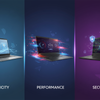Google Pixel 8 & 8 Pro hands-on review
Introduction
The market of smartphones has radically grown in the last ten years, among which the foldable devices turned out to be the most exciting innovative product. When Samsung first came up with the Galaxy Fold in 2019, it opened up a completely new concept in mobile technology.
As one of the pioneers in this field, Samsung gained the peak of foldable smartphone sales right from the very first launches such as the Galaxy Z Fold and Z Flip series. On the other hand, the competitive landscape changes extremely fast all the time, with Google's latest offer—Pixel 9 Pro Fold—being a big challenger, and maybe a hint that the Samsung leadership in foldable development races is becoming a relic of the past.
The Google Pixel 9 Pro Fold isn't any foldable gadget; rather, it's a product that further steps away from traditional phones and pushes the envelope on what can be created with a foldable smartphone.
Testament to this are works in the form of innovative design, state-of-the-art tech, and such a nuanced focus on user experience that plants Google on a pedestal not even Samsung can climb. Within this blog post, we will take a look at how, through its Pixel 9 Pro Fold, it sparked a shift in foldables and left many asking if Samsung's dominance in the space may be on the back foot.
The Foldable Market: A Brief Overview
Foldable smartphones have remained slightly niche in the mobile market. Early mover advantages, therefore, had accrued to Samsung since it was there up front taking the lead in dominating this market with products like Z Fold and Z Flip. That the devices were pioneering, providing users that one-off novelty of a foldable screen with functionalities associated with a smartphone and tablet in one, did not hurt.
Samsung worked around iterative improvements by iterating their foldable devices in every generation.
Undoubtedly, behemoths from technology were never much far from each other: Huawei, Motorola, and Xiaomi also journeyed in launching their take of foldable smartphones with some weirdness in its form factor. Things really got a move on in market dynamics once Google itself decisively entered the fray with its Pixel Fold series.
Google Entry: A Game-Changer
For years, it felt like the world was just waiting for Google to throw its hat in the foldable ring; rumors and leaks of a supposed Pixel Fold go way back before any kind of official announcement. So when the Pixel 9 Pro Fold finally did arrive on the scene, it immediately became clear that Google wasn't simply playing catch-up: It was, instead, aiming for a much bolder vision of the foldable future.
Google’s approach to the Pixel 9 Pro Fold was different from Samsung’s in several key aspects:
1. Software Integration:
Years of software experience and know-how went to the translation of the foldable screen and the Android operating system. In contrast to what seemed to be untouched for this new foldable format, often considered too eccentric about software, Samsung's foldables have been pinpointed for giving Google the freedom to let loose with its first hardware in this category.
2. Design Philosophy:
The Pixel 9 Pro Fold is designed to be more practical with a user orientation embodied in minimalism adopted for this device by Google. This device shall be thinner, lighter, and ergonomically made than all other similar products under Samsung; that is, it shall be easier to be operated whether as a phone or as a tablet.
3. Camera Technology:
Following on the theme of labelling Google's Pixel phones as great largely owing to their cameras within the tech community for years, the Pixel 9 Pro Fold should prove no exception. The foldable integrates the newest computational photography from Google himself to help it deliver better cameras than the Samsung Galaxy Z Fold series.
4. Longevity and Durability:
On the other hand, the main drawback of the early foldable designs in the case of Samsung is this weakness in the brand. For Google, it dictates harnessing softwareization in the manufacture of materials for the Pixel 9 Pro Fold Device to ensure that the regular tear and wear mentioned above is met with a hunky and strong device.
Design and Build Quality: Google Sets a New Standard
In this respect, the main part of credit can be given to the design and fabrication quality of the Pixel 9 Pro Fold. For those of us who have been disappointed with most equipment released by Samsung for foldable devices, this seems to be an exception—as it won't fall behind appealing either in holding or in use.
The Hinge Mechanism:
Google went ahead to refurbish this through a trendsetting hinge design that not only pushes all the right points but, at the same time, evidently avails a longevity feature—it will go down perfectly flat, with no gap availing problems found in Samsung foldables.
Display Innovation:
The Pixel 9 Pro Fold features the latest technology in foldable displays, which is not only flexible but also more resistant to the pesky folds people often get with regular Samsung foldables. Google managed to finish off a display most attractive and issue in durability through the addition of its ultra-thin glass along with a new protective layer.
Materials and Finish:
The Pixel 9 Pro Fold by Google offers premium top-materials such as the metal frame and ceramic back, one reason it would feel a little premium. With that, it is also lighter, therefore easier to handle and more comfortable to be with for longer hours than the Galaxy Z Fold series.
Software Experience: The Pixel Advantage
One area where Google has continuously stood out with its Pixel devices in comparison to the competition is the software experience, and that does not change much, or maybe at all, with the Pixel 9 Pro Fold. With stock software in all of its purity, the Pixel 9 Pro Fold brings with it a cleaner and more concise user experience as compared to Samsung's One UI.
Seamless Transition Between Screens:
Google has worked on the optimization of the Android experience to be better on the foldable form factor—an optimization that makes sure apps easily switch from the external to the internal screen. Some of Samsung foldables have been problematic and often require specific changes by app developers for the devices.
Enhanced Multitasking:
The Pixel 9 Pro Fold really is one of the best multitaskers on any smartphone—flitting between loads of apps without blinking. All this is going to make the split-screen and multi-windows modes much more user-friendly and intuitive through software optimizations, which definitely have got to be better than Samsung's, hence really unleashing the value of the foldable form factor.
Google’s AI and Machine Learning Integration:
The Pixel 9 Pro Fold brings together the full brunt of the AI and machine learning expertise of Google, stretching from smart features such as predicative text and voice recognition to camera improvements that have no other match on foldables. None of them, though, carry quite the same weight of smart software integration as do the Samsung foldables.
Camera Innovations: Pixel 9 Pro Fold Takes the Lead
As Google Pixel has revolutionized smartphone photography from the appearance of the Pixel series, it does the same for the Pixel 9 Pro Fold. So, the triple camera on this rear consists of a primary one, an ultra-wide lens, and a telephoto lens—all enhanced due to the computational photography algorithms by Google.
Superior Image Processing:
Google photo processing provides a fair share of uncanny sharpness and enables just the correct dynamic range and color accuracy in comparison with the Galaxy Z Fold series.
Advanced Video Capabilities:
Another field in which the Pixel 9 Pro Fold is one of the best is video recording, with features such as 8K video, real-time HDR, and advanced stabilization. In fact, this will take capabilities with the Pixel 9 Pro Fold a step further than those of Samsung, which—operating in the best-of workplaces—do not perhaps compare on the video quality with that much versatility.
Battery Life and Performance: Google Delivers
In that respect, battery life always seemed to be one of the problems with foldables: a double-edged sword with the power consumption such a large, high-resolution screen would warrant. Google, instead, approached the Pixel 9 Pro Fold with the establishment of some new large-battery standards and power management optimization through software.
Efficient Power Management:
Even the software optimizations done by Google achieved the extent of power management that allows the Pixel 9 Pro Fold to get better battery life compared to any Samsung foldable. In a nutshell, it performs smart background management along with screen brightness and other connectivity features to eke out better battery life without added compromise toward performance.
Performance Powerhouse:
The processor in the new Pixel 9 Pro Fold promises the performance it needs to ensure it is at the top of both packs, the phone and the tablet. Gaming, multitasking, or media consumption—the Pixel 9 Pro Fold offers a seamless and responsive experience outshining Samsung's offerings.
Durability and Longevity: Pixel 9 Pro Fold Holds Up
One of the main criticisms of early foldables is the fact that they were not that durable. The greatest setbacks of the past Galaxy Z Fold series by Samsung were the fragility of the screen and the hinge mechanisms. Google addressed both with the Pixel 9 Pro Fold, using new materials and techniques of engineering.
Durable Build:
The joint housing on this thing is remarkably better than past models, all around a hinge design that will easily deal with hours of open and closing with no degradation in quality. The device is also water and dust resistant, making this feel like an added structural resiliency layer when compared to Samsung's foldables.
Long-Term Software Support:
Additionally, one area where the Pixel 9 Pro Fold clearly outshines the competition from Samsung would be in long-term software support. Admittedly, Samsung does offer software updates for its devices, but great priority and urgency shape the installments arranged by Google. This calls for the issue of timely updates managed to drip down for at least up to five years for the Pixel 9 Pro Fold, keeping it on par and running as well with new features and security patches.
The Competitive Landscape: Samsung’s Struggles
Nevertheless, all of this Samsung foldables market domination is challenged by Google, which not a single manufacturer is able to do. It's only compatible to mention the Pixel 9 Pro Fold under the headline "innovative design coupled with leading world-class software experience and unlimited technology enclosed within a fold.".
Samsung’s Iterative Approach:
Iterative device development is one of the reasons Samsung perhaps loses the foldable race. With each new addition to the Galaxy Z Fold and Z Flip series, the company might have brought incremental changes, but they have been exactly that: incremental. The Pixel 9 Pro Fold is more of a giant move forward, huge in design and functionality.
Price and Value Proposition:
An aspect in which Samsung has not worked has been its price point. The Galaxy Z Fold series parades one of the most expensive smartphones in the market, and though the Pixel 9 Pro Fold is a premium-level device too, it actually gives a run for the money through its value relative to the features and performance. Surely, with such pricing, there is going to be additional heat applied to Samsung's market share - foldables specifically.
Innovation Fatigue:
An early edge in the foldable market perhaps put Samsung on the path to innovation fatigue: old hardware features relied upon instead of new, radically fresh ones. Google's Pixel 9 Pro Fold, on the other hand, with the news of so much fresh ground covered by the company, can definitely capture the whimsy of a consumer desperate to be heavily surprised.
Conclusion
A Power Shift The launch of an all-new Google Pixel 9 Pro Fold is way above another new entry into the already fast-buzzing foldable smartphone market. While Samsung mops up the market courtesy of first mover, Google is trying: the best possible to challenge that with its new offering that shall help raise the bar for design, software experience, camera technology, and general performance. Though Samsung still puts up a good fight in the foldable market, success for the Pixel 9 Pro Fold clearly spells out one thing: the race is far from over.
Google's entry into the segment did up the ante, and Samsung would have to innovate far more aggressively if it wants to get back lost glory. Benefiting consumers the most, with more options available and innovation heating up, competition under a better offering of products is the foldable segment.
In conclusion, the fight between Samsung and Google in the foldable space spells good news for the common consumer. While one might want to salivate over the creativity emanating from the Pixel 9 Pro Fold, another only convinces himself of what would have befallen Samsung if they had not played their cards to perfection. With the two in a tussle, this development for the consumer would drive itself in appreciating what each one was capable of. The heat is really on right now in the foldable space.
FAQs
1. How does this Pixel 9 Pro Fold differ from most of these foldable phones?
The Pixel 9 Pro Fold from Google will host some of the most advanced foldable displays, bringing seamless switching combined with modern technological features. AI-driven features and a robust design make this device quite a strong contender within the foldable segment.
2. How does the future Google Pixel 9 Pro Fold differ from the latest foldables publications by Samsung?
The Google Pixel 9 Pro Fold, at the same time, posits a big threat to the Samsung foldable lineup through wicked software integration and a much more clever design for a refined user experience. This screen uses more competition for the user experience in a way that makes Google proud.
Where Samsung has been front-running with the foldable technology for years, advancements in Pixel 9 Pro Fold reveal how Google has been playing catch-up, or even leading in some areas of this technology.
3. What are some of the important functionalities of the Google Pixel 9 Pro Fold that suggest Samsung is trailing hard in this foldable race?
Among the standout features, however, is the stronger yet more versatile foldable display of the Pixel 9 Pro Fold, multitasking features, and a higher camera grade incorporated with the telephoto lens along with the improvement in its software-wise by the utilization of Google AI logic. Hereby, it will key in around difficulties experienced by Samsung, most especially in areas of durability and software optimization.
4. Is the Google Pixel 9 Pro Fold cheaper compared to foldable models of Samsung?
The pricing, or rather expected pricing for the Google Pixel 9 Pro Fold, is expected to bring a premium experience that edges below the higher-end foldables that Samsung offers. This has to be the fact, even though the aspect of pricing is not clear yet, meaning that Google is yet to go for a lukewarm, welcoming look at that affordable pricing while keeping up the quality and innovation.
5. What would the effects on the folded mobile markets be like with the arrival of a Google Pixel 9 Pro Fold?
The release of the Google Pixel 9 Pro Fold could lead market dynamics to further heights and probably increase the pressure on Samsung and other competitors to rise, continuing to raise the bar for innovation. With Google making a move to enter into the foldables arena with the powerhouse, such as this one, it may encourage the bottom-feeding companies on into more competition, hence better serving the consumer with faster advancements of foldable technology across the industry.




